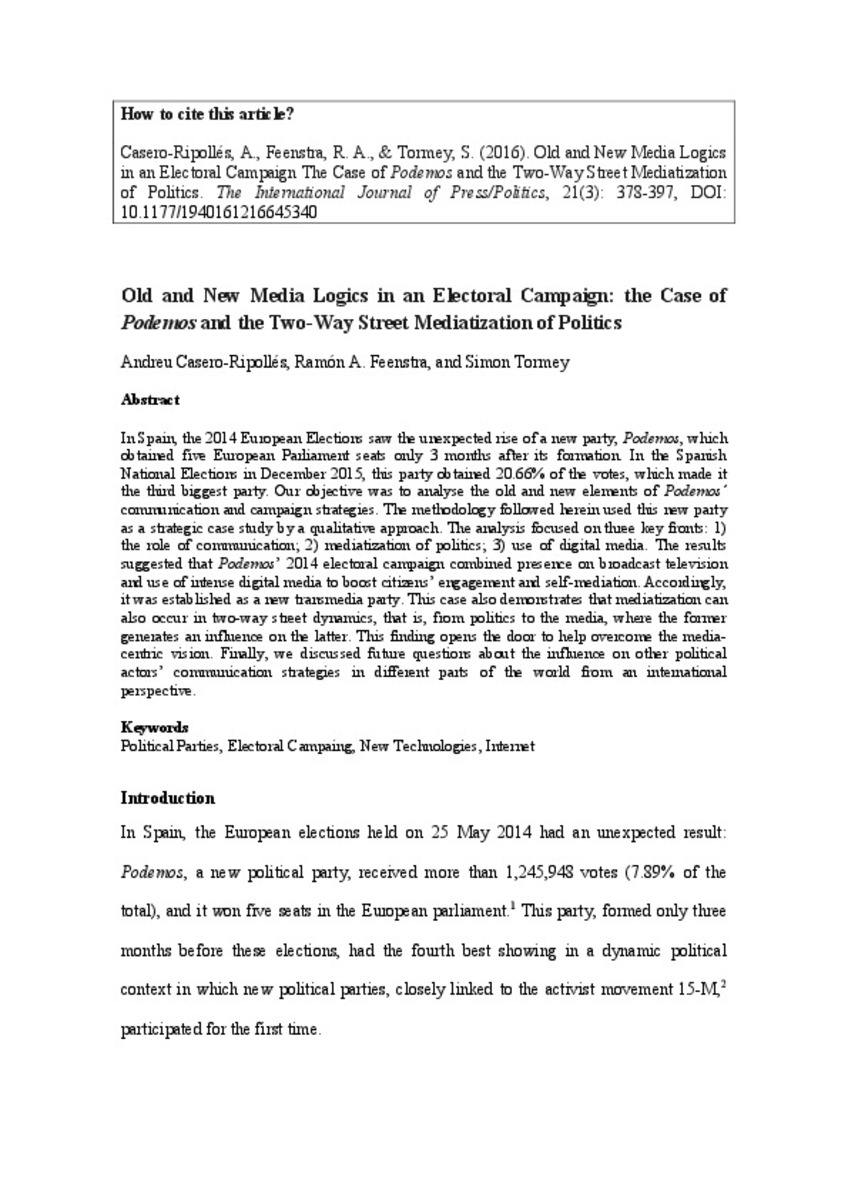Mostrar el registro sencillo del ítem
Old and New Media Logics in an Electoral Campaign: The Case of Podemos and the Two-Way Street Mediatization of Politics
| dc.contributor.author | Casero-Ripolles, Andreu | |
| dc.contributor.author | Feenstra, Ramón A. | |
| dc.contributor.author | Tormey, Simon | |
| dc.date.accessioned | 2016-07-13T11:01:14Z | |
| dc.date.available | 2016-07-13T11:01:14Z | |
| dc.date.issued | 2016-04 | |
| dc.identifier.citation | CASERO-RIPOLLÉS, Andreu; FEENSTRA, Ramón A.; TORMEY, Simon. Old and New Media Logics in an Electoral Campaign The Case of Podemos and the Two-Way Street Mediatization of Politics. The International Journal of Press/Politics, 2016, p. 1940161216645340. | ca_CA |
| dc.identifier.uri | http://hdl.handle.net/10234/161683 | |
| dc.description.abstract | In Spain, the 2014 European Elections saw the unexpected rise of a new party Podemos, which obtained five European Parliament seats only three months after its formation. In the Spanish National Elections in December 2015, this party obtained 20.66 percent of the votes, which made it the third biggest party. Our objective was to analyze the old and new elements of Podemos’ communication and campaign strategies. The methodology followed here used this new party as a strategic case study by a qualitative approach. The analysis focused on three key fronts: (1) the role of communication, (2) mediatization of politics, and (3) use of digital media. The results suggested that Podemos’ 2014 electoral campaign combined presence on broadcast television and use of intense digital media to boost citizens’ engagement and self-mediation. Accordingly, it was established as a new transmedia party. This case also demonstrates that mediatization can also occur in two-way street dynamics, that is, from politics to the media, where the former generates an influence on the latter. This finding opens the door to help overcome the media-centric vision. Finally, we discussed future questions about the influence on other political actors’ communication strategies in different parts of the world from an international perspective. | ca_CA |
| dc.description.sponsorShip | The author(s) disclosed receipt of the following financial support for the research, authorship, and/or publication of this article: This article is part of the research project CSO2014-52283-C2- 1-P, and FI2013-47136-C2-2-P funded by the Spanish Ministry of Economy and Competitiveness (State Plan of Scientific and Technical Research and Innovation 2013-2016). | ca_CA |
| dc.format.extent | 20 p. | ca_CA |
| dc.format.mimetype | application/pdf | ca_CA |
| dc.language.iso | eng | ca_CA |
| dc.publisher | Sage | ca_CA |
| dc.relation.isPartOf | The International Journal of Press/Politics April 22, 2016 | ca_CA |
| dc.rights | Copyright © 2016 by SAGE Publications | ca_CA |
| dc.rights.uri | http://rightsstatements.org/vocab/InC/1.0/ | * |
| dc.subject | political parties | ca_CA |
| dc.subject | electoral campaign | ca_CA |
| dc.subject | new technologies | ca_CA |
| dc.subject | Internet | ca_CA |
| dc.title | Old and New Media Logics in an Electoral Campaign: The Case of Podemos and the Two-Way Street Mediatization of Politics | ca_CA |
| dc.type | info:eu-repo/semantics/article | ca_CA |
| dc.identifier.doi | http://dx.doi.org/10.1177/1940161216645340 | |
| dc.rights.accessRights | info:eu-repo/semantics/openAccess | ca_CA |
| dc.relation.publisherVersion | http://hij.sagepub.com/content/early/2016/04/21/1940161216645340.abstract | ca_CA |
Ficheros en el ítem
Este ítem aparece en la(s) siguiente(s) colección(ones)
-
COM_Articles [809]







